Product Description
View a complete crosswalk of changes from the sixth and seventh editions! (Includes text, tables, and figures.)
Managing Health Services Organizations and Systems has served the educational and professional needs of the healthcare field over four decades. The seventh edition furthers that legacy in a completely revised and reorganized text that presents a comprehensive range of the knowledge and skills needed to effectively lead and manage health services delivery.
The first of three parts describes the environment in which health services are delivered. The second details tools and skills needed to manage and lead health services. The final part links the preceding chapters to Fayol’s five management functions—planning, organizing, staffing, directing, and controlling—as they apply in health services.
In this edition, the authors return to basics in a concise yet substantive presentation within a context of quality and performance improvement. New to this edition are chapters on healthcare economics, financial management, planning, organizing, staffing, and directing. A new section on compliance is key to meeting regulatory demands. The sections on patient and staff safety, emergency preparedness, and project management are updated and revised. Additional highlights include
- Revised and supplemented end-of-chapter discussion questions
- 52 thought-provoking case studies, 28 new to this edition
- Extensive source citations, many with URLs leading to additional sources for reading and research
- List of acronyms
- Detailed index
- Supporting instructor materials, including 58 additional case studies
Managing Health Services Organizations and Systems is a vital resource for developing health services leaders and managers. It is
- A textbook for graduate and undergraduate courses in health services management
- A resource for nonformal education such as seminars, webinars, and self-instruction
- An enduring professional reference with encyclopedic information. Busy practitioners will value the readily available acronym list, detailed index, and regulatory and statutory references.
Faculty adopting this text will find exceptional support in the accompanying instructor materials. These include learning objectives, supplemental case studies, discussion questions and answers, PowerPoint presentations, and test banks for each chapter. Also available are PDF files of figures and tables.
Format: E-book
e-ISBN 978-1-938870-91-0
E-book available through:
Also available through: Baker and Taylor, EBSCO, Chegg, Follett, Gardners, ProQuest, Login Canada, and RedShelf
About the Authors
Preface
About this Edition
Acknowledgments
Acronyms Used in Text
Dedication
PART I. THE ENVIRONMENT
Chapter 1: Healthcare in the United States
- Health and System Goals
- Lack of Synchrony
- Processes That Produce Health Policy
- A Brief History of Health Services in the United States
- Other Western Systems
- Structure of the Health Services System
- Classification and Types of HSOs/HSs
- Local, State, and Federal Regulation of HSOs/HSs
- Other Regulators of HSOs/HSs
- Accreditation in Healthcare
- Education and Regulation of Health Services Managers
- Regulation and Education of Selected Health Occupations
- Associations for Individuals and Organizations
- Paying for Health Services
- Government Payment Methodologies
- System Trends
- Case Study 1. Gourmand and Food—A Fable
- Case Study 2. Normal Saline and Hurricane Maria NEW!
- Case Study 3. Bipartisan Policy Group Proposes Cuts to Hospital Spending
NEW!
Notes
Chapter 2: Ethical and Legal Environment
- Society and the Law
- Relationship of Law to Ethics
- Ethics Framework
- Personal Ethic and Professional Codes
- Health Services Codes of Ethics
- Ethical Issues Affecting Governance and Management
- Biomedical Ethical Issues
- End-of-Life Decisions
- Organizational Responses to Ethical Problems
- Managers and the Law
- Torts and HSOs/HSs
- Reforms of the Medical Malpractice System
- Select Legal Areas Affecting HSOs/HSs
- Legal Process of a Civil Lawsuit
- Special Considerations for the Manager
- Case Study 1. Understanding
- Case Study 2. Viral Pandemic NEW! (Based on COVID-19)
- Case Study 3. Concerned Physicians, Unconcerned Managers NEW!
- Case Study 4. Which Hurts More: The Truth or the Lie? NEW!
Notes
Chapter 3: Healthcare Economics
- Economic Growth in Healthcare
- Special Characteristics of the Healthcare Economy
- Healthcare Demand
- Healthcare Supply
- Economic Solutions for Healthcare
- Case Study 1. Price and Discount Transparency NEW!
- Case Study 2. Comparing Health Care in High-Income Countries NEW!
- Case Study 3. The Role of Health Insurance in Guaranteeing Access to Healthcare NEW!
- Case Study 4. Physician Consolidation NEW!
Notes
Chapter 4: The Quality Imperative: The Theory
- Improving Quality and Performance
- Importance of QI
- Background to the Present Focus on Quality Improvement
- Taking a CQI Approach
- CQI, PI, and Competitive Position
- Theory of CQI
- Strategic Quality Planning: Hoshin Planning
- Two Models to Improve Processes
- Organizing for Improvement
- The Next Iteration of CQI: A Community Focus
- Case Study 1. Extent of Obligation
- Case Study 2. Surgical Safety—Retained Foreign Objects
- Case Study 3. Which Team’s Fastest? NEW!
Notes
Chapter 5: Healthcare Technology
- Background
- Types of Technologies
- Effects of Technology on Health Status
- Forces Affecting Development and Diffusion of Technology
- Responses to Diffusion and Use of Technology
- Health Technology Assessment
- HSO/HS Technology Decision Making
- Managing Biomedical Equipment
- Health Information Technology
- Telemedicine
- Enterprise-Level EHRs
- Future Developments
- Technology and the Future of Medicine
- Case Study 1. Is Cleansing Your Hands in my Room a Problem, Doctor? NEW!
- Case Study 2. “Who Does What?”
- Case Study 3. “Let’s ‘Do’ a Joint Venture”
Notes
PART II. THE TOOLS
Chapter 6: Managerial Problem Solving and Decision Making
- Problem Analysis and Decision Making
- Problem Solving
- Process and Model
- Influencing Problem Solving and Decision Making
- Unilateral and Group Problem Solving
- Problem-Solving and Decision-Making Styles
- Case Study 1. The Nursing Assistant
- Case Study 2. The New Charge Nurse
- Case Study 3. Chris’s New Baby NEW!
Notes
Chapter 7: Financial Management
- Organization of Financial Management
- Healthcare Financial Accounting
- Cost Accounting
- Reimbursement
- Working Capital
- Resource Allocation
- Case Study 1. Calculating Net Patient Services Revenue NEW!
- Case Study 2. Calculating Bad Debt Expense NEW!
- Case Study 3. Analyzing Financial Statements NEW!
- Case Study 4. Break-even Analysis for a Capitated Contract NEW!
- Case Study 5. Your Organization’s Path to the Second Curve: Integration and Transformation NEW!
- Case Study 6. Economic Order Quantity and Total Cost NEW!
Notes
Chapter 8: The Quality Imperative: Implementation
- Undertaking Process Improvement
- Other Improvement Methodologies
- Improvement and Problem Solving
- Statistical Process Control (SPC)
- Tools for Improvement
- Productivity and Productivity Improvement
- LIPs and CQI
- Patient and Staff Safety in Healthcare
- QI Methods Useful in Patient and Staff Safety
- Overlap of Patient and Staff Safety
- Sustainability
- Case Study 1. The Carbondale Clinic
- Case Study 2. Respiratory Pandemic and the Hospital NEW!
- Case Study 3. Infections—CLABSI
- Case Study 4. Sharps Injuries
- Case Study 5. Violence in the Workplace
Notes
Chapter 9: Communicating
- Communicating Is Key to Effective Stakeholder Relations
- Communication Process Model
- Barriers to Effective Communication
- Flow of Intraorganizational Communication
- Communicating with External Stakeholders
- Special Situations of Communicating with External Stakeholders
- Communicating with Internal Stakeholders
- Case Study 1. How Much Should We Say?
- Case Study 2. Getting Help When Needed
- Case Study 3. Adding Verbal Orders to Written Orders NEW!
Notes
PART III. APPLICATION
Chapter 10: Planning
- Strategizing and Systems Theory
- Strategizing and Planning
- The Strategizing Process
- Situational Analysis
- Internal Environmental Analysis
- External Environmental Analysis
- Formulating Strategy
- Implementing Strategy
- Strategic Control
- Strategic Marketing
- Core Concepts in Marketing
- Examples of Marketing Strategies
- Strategic Issues Management
- Case Study 1. No Time for Strategizing
- Case Study 2. A Response to Change
- Case Study 3. HSO Strategic Assessment NEW!
Notes
Chapter 11: Organizing
- Designing the Organization
- Culture and Values
- Theoretical Background
- Formal and Informal Organizations
- Designing Interorganizational Relationships
- The Triad of Key HSO Components
- Organization of Select HSOs
- Health Systems
- Diversification in HSOs and HSs
- The HSO/HS Environment
- Case Study 1. The Clinical Staff
- Case Study 2. State Allocation Decisions—Centralize or Decentralize NEW!
- Case Study 3. Physicians’ Unprofessional Behavior NEW!
- Case Study 4. CEO Salary versus Patient Care NEW!
Notes
Chapter 12: Staffing
- Background
- Staffing
- HRM Activities
- Labor Relations Law and Unionization
- Self-service HR
- Foreign Workers
- Teams
- Virtual Workforce
- Social Media in the Workplace and in HR
- Personality Testing
- Outsourcing Some HRM
- Case Study 1. Today’s Workforce
- Case Study 2. The Photographer Who Posed as a Gynecologist NEW!
- Case Study 3. Doctor of Death NEW!
- Case Study 4. Let the Punishment Fit the Crime NEW!
Notes
Chapter 13: Directing
- Directing as Leading: Defined and Modeled
- Work of Managers
- Management Functions, Skills, Roles, and Competencies
- Managers and Leaders: Are They Different?
- Ethical Responsibilities of Leaders
- Power and Influence in Leading
- Motivation Defined and Modeled
- Conclusions About Power, Influence, and Motivation in Leading
- Approaches to Understanding Leadership
- Toward an Integrative Approach to Effective Leading
- Case Study 1. Healthcare Executives’ Responsibility to Their Communities
- Case Study 2. The Young Associate’s Dilemma
- Case Study 3. Ethical Aspects of Leadership
- Case Study 4. Reluctant Leader NEW!
Notes
Chapter 14: Controlling
- Monitoring (Control) and Intervention Points
- Control Model
- Levels of Control
- Control Considerations
- Control and CQI
- Control and Problem Solving
- Control and Information Systems
- Risk Management and Quality Improvement
- Healthcare and Public Health Emergency Preparedness
- Control Methods
- Project Management
- Case Study 1. Centralized Printers
- Case Study 2. Healthcare Emergency Preparedness
- Case Study 3. Placing Imaging Services to Support ED Operations
Notes
Index
 Kurt Darr, JD, ScD, LFACHE, is Professor Emeritus of Hospital Administration, and of Health Services Management and Leadership, Department of Health Services Policy and Management, School of Public Health, The George Washington University.
Kurt Darr, JD, ScD, LFACHE, is Professor Emeritus of Hospital Administration, and of Health Services Management and Leadership, Department of Health Services Policy and Management, School of Public Health, The George Washington University.
Dr. Darr holds the Doctor of Science from The Johns Hopkins University and the Master of Hospital Administration and Juris Doctor from the University of Minnesota. His baccalaureate degree was awarded by Concordia College, Moorhead, MN.
Dr. Darr completed an administrative residency at the Rochester (MN) Methodist Hospital and subsequently worked as an administrative associate at the Mayo Clinic. After being commissioned in the U.S. Navy during the Vietnam War, he served in administrative and educational assignments at St. Albans Naval Hospital (NY) and Bethesda Naval Hospital (MD). He completed postdoctoral fellowships with the U.S. Department of Health and Human Services, the World Health Organization, and the Accrediting Commission on Education for Health Services Administration.
Dr. Darr is admitted to practice before the Supreme Court of the state of Minnesota and the Court of Appeals of the District of Columbia. He was a mediator for the Civil Division of the Superior Court of the District of Columbia and has served as a hearing officer for the American Arbitration Association. Dr. Darr is a member of hospital committees on quality improvement and on ethics in the District of Columbia metropolitan area. He is a Life Fellow of the American College of Healthcare Executives.
Dr. Darr’s teaching and research interests include health services management, administrative and clinical ethics, hospital organization and management, quality improvement, and applying the Deming method in health services. Dr. Darr is the editor and author of numerous books, articles, and cases used for graduate education and professional development in health services.
Michael Nowicki, M.H.A., Ed.D., FACHE, FHFMA, holds an Ed.D. degree in Educational Policy Studies & Evaluation from the University of Kentucky and a master of hospital administration from George Washington University. He is currently a professor of health administration at Texas State University. Board certified in both healthcare management and healthcare financial management, he is a fellow of the American College of Healthcare Executives and the Healthcare Financial Management Association. Dr. Nowicki has held various administrative positions in healthcare organizations around the country. He is a noted speaker and author on healthcare financial management.
The 7th Edition
Instructor Resources
A rich array of downloadable materials is available to instructors by request to help with designing their courses when using the 7th edition of MHSOS. All materials are updated from the last edition and more have been added. Among these materials are:
- Instructor Manual containing supplemental materials for each chapter, including learning objectives and additional case studies not found in the book
- Customizable PowerPoint presentations for each chapter, totaling over 400 slides
- New to this edition: A test bank of multiple-choice and essay questions developed for each chapter
- PDF files of figures and tables for use in PowerPoint slides, tests, handouts, and the like
Crosswalk of Changes
View a complete crosswalk of changes from the sixth and seventh editions! (Includes text, tables, and figures.)
About this Edition
The five chapters in Part I, “The Environment,” describe the setting and provide a context for delivery of services.
- Chapter 1, “Healthcare in the United States,” identifies and describes public and private entities, knowledge about which is the grounding for understanding, organizing, and delivering health services. Organizations, regulators, educators, accreditors, and financing are discussed.
- Chapter 2, “Ethical and Legal Environment,” shows the pervasive role of ethics and law in health services. Ethical frameworks are described, ethical issues are identified, and organizational responses to them are suggested and analyzed. Law is the minimum level of performance for managing health services. The relationship of the law to the work of managers is highlighted.
- Chapter 3, “Healthcare Economics,” is new to this edition. Understanding macroeconomics is essential for the educated health services manager. The information here helps users comprehend effects of the economic environment on organizing, financing, and delivering health services.
- Chapter 4, “The Quality Imperative: The Theory,” highlights and analyzes the theoretical underpinnings of quality and performance improvement (Q/PI). It details the history of efforts to improve quality in clinical medicine. By comparison, applying Q/PI to managing health services delivery is in its infancy. This chapter is prelude to the Q/PI applications discussed in Chapter 8.
- Chapter 5, “Healthcare Technology,” describes the history, effects, and diffusion of health services technology and how HSOs/HSs acquire and manage it. American health services delivery is technology centric; a basic understanding is essential to managing health services effectively.
The four chapters in Part II, “The Tools,” discuss the medium or adjunct skills needed to manage health services delivery.
- Chapter 6, “Managerial Problem Solving and Decision Making,” develops and applies a problem-solving model. Managers are problem solvers. Were there no problems to solve, managers would not be needed.
- Chapter 7, “Financial Management,” is new to the 7th edition. Any effective, successful manager must understand financial and quantitative data and have the ability to use data for problem solving and decision making.
- Chapter 8, “The Quality Imperative: Implementation,” applies Q/PI. It details how HSOs/ HSs make continuous improvement of quality and productivity a reality. Improving processes improves quality. The result is enhanced productivity. Effective Q/PI requires a commitment from governance, management, clinicians, and staff to apply the methods and tools described.
- Chapter 9, “Communicating,” analyzes this essential skill and posits a process model that is applied to communicating in organizations and systems and between them and their external stakeholders.
The five chapters in Part III, “Application,” are the culmination of the nine chapters in Parts I and II. Here, information about the environment and the tools are applied to Fayol’s taxonomy of the five management functions. These functions encompass all that managers do. Separate chapters detailing the functions are new to the 7th edition and provide the orientation and skills set needed for effective and efficient management.
- Chapter 10, “Planning,” is the first of Fayol’s management functions. The other four functions follow as a logical consequence of managing. Planning what is to be done is the essential framework for applying the other functions. Planning includes strategizing or identifying and addressing opportunities and threats.
- Chapter 11, “Organizing,” applies the second of the five management functions. Highlighted are the theory and ways to organize HSOs/HSs. As is typical, form follows function: The plan and what is to be done determine an organization’s structure, content, and relationships.
- Chapter 12, “Staffing,” is new to this edition. The staffing function is commonly known as human resources management (HRM). Given that HSOs are labor-intensive, the importance and contribution of staffing to organizational success are difficult to overstate.
- Chapter 13, “Directing,” is the fourth management function. The work of managers and the work of leaders are differentiated. The extensive literature on functions, skills, roles and competencies, and leadership theories is reviewed. Motivation is defined and modeled. Power, influence, and motivation are analyzed in the context of understanding leadership and developing an integrative approach to leading as directing.
- Chapter 14, “Controlling,” presents a general model of control and focuses on controlling individual and organizational work results using management information systems, management and operations auditing, HRM, compliance, and budgeting. Control of healthcare quality using risk management and quality assessment and improvement are discussed. The chapter concludes with a comprehensive section on project management.
Book Features
Each chapter includes:
- A chapter outline
- Discussion questions
- Several case studies, each with discussion questions
- Extensive updated endnotes and sources
- Numerous exhibits to enhance instruction and ease learning
- URLs to Internet sources for further information and study
Additional resources in the book:
- Acronym list
- Detailed index
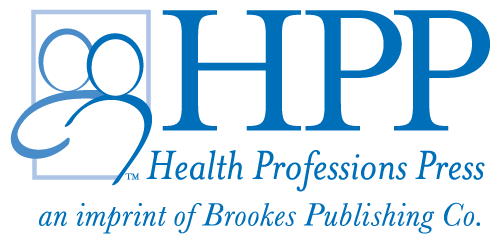
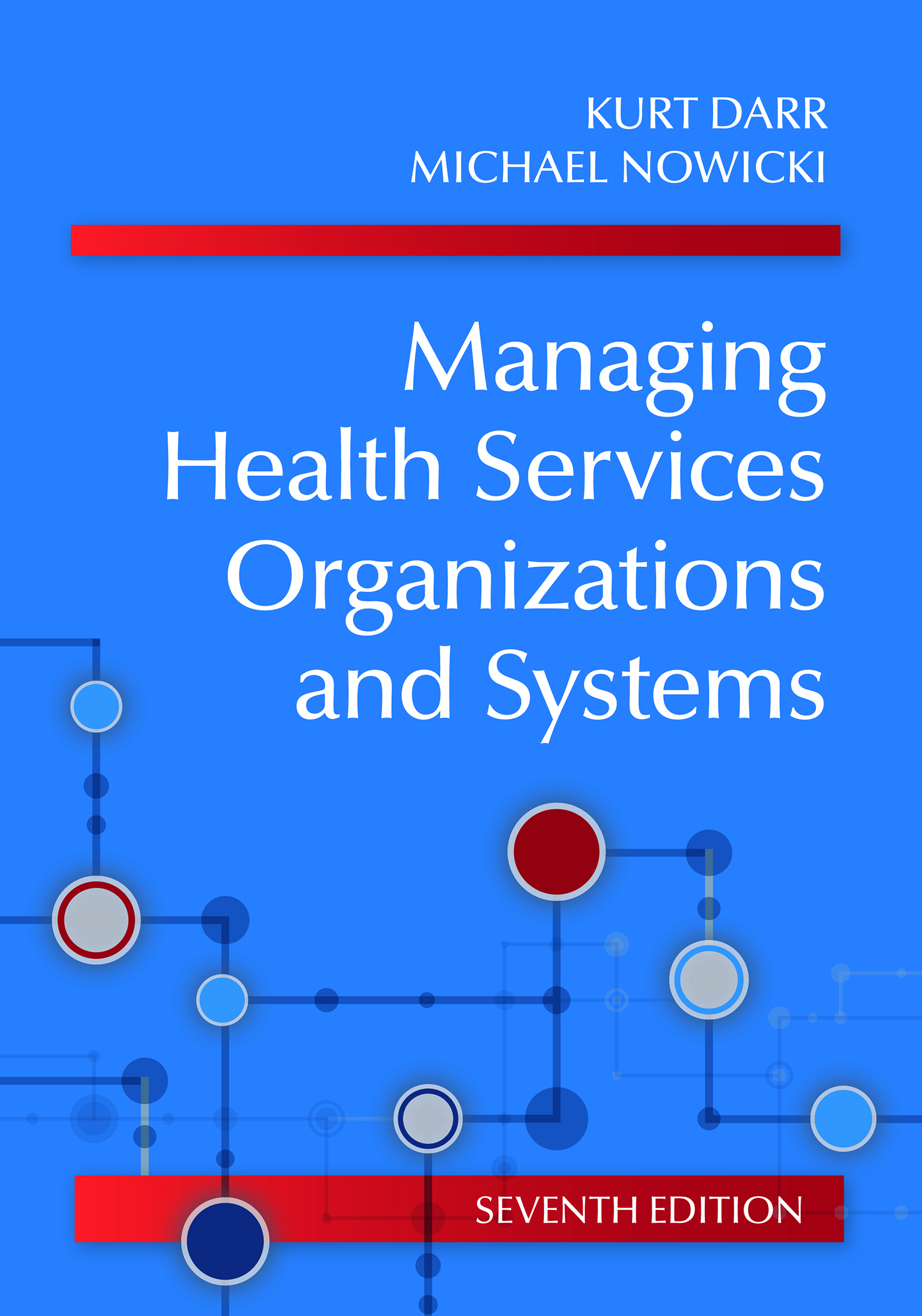
 Kurt Darr, JD, ScD, LFACHE, is Professor Emeritus of Hospital Administration, and of Health Services Management and Leadership, Department of Health Services Policy and Management, School of Public Health, The George Washington University.
Kurt Darr, JD, ScD, LFACHE, is Professor Emeritus of Hospital Administration, and of Health Services Management and Leadership, Department of Health Services Policy and Management, School of Public Health, The George Washington University.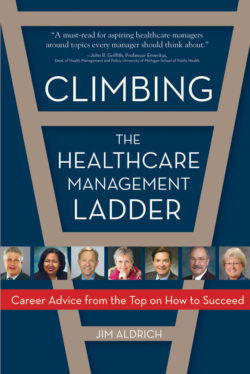

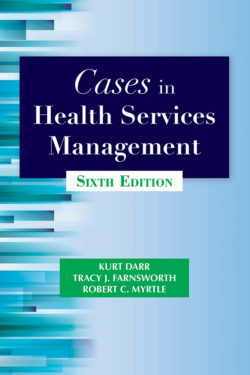

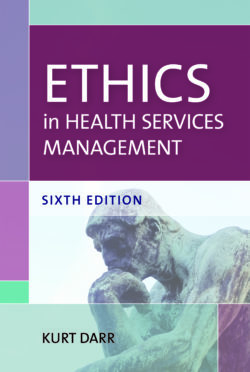
HPP Admin –
“As a resident PGY-1 this book gave me the tools and confidence to not only manage myself but also manage multidisciplinary teams. It explains almost all factors to consider when entering the world of healthcare management in a simple yet efficient manner. I will be referencing this book now and in the years to come.”
-Mitchel Cruz, D.O., Oklahoma State University FM Resident, PGY-1, OSU Center for Health Sciences